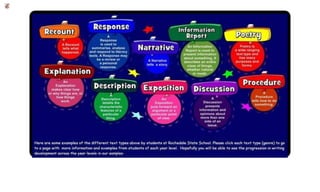Reading narratives is essential for learning as it develops critical thinking, empathy, and creativity. Narratives offer a unique perspective that cannot be found in other materials. To gain a deeper understanding, readers should use strategies like identifying the main idea, making connections, visualizing scenes, and asking questions. It is important to determine key ideas, cite evidence to support statements, and analyze the author's message and themes expressed. Overall, reading narratives cultivates important learning competencies.








![The Hare and the Tortoise
There was once a hare who was friends with a tortoise. One day, he
challenged the tortoise to a race. Seeing how slow the tortoise was going,
the hare thought he would win this easily. So, he took a nap while the
tortoise kept on going. When the hare woke up, he saw that the tortoise was
already at the finish line. Much to his chagrin, the tortoise won the race while
the hare was busy sleeping.
[Adapted from The Hare and the Tortoise by Aesop (c. 620 BCE-564 BCE].
A narrative usually has 3 parts:
a beginning, middle and end – but they are not always the same length.](https://image.slidesharecdn.com/readingthetext-narratives-240116032033-6c812053/85/Reading-the-text-Narratives-pptx-9-320.jpg)

![Questions:
Q1.Name the main characters.
Q2.What event and /or character sets the action going/ causes the problem?
Q3.Who won the race and how did he win it?
Questions:
Q4.What is the moral/lesson of the story?
Q5.“The Hare is the villain/bad character in the story” – do you agree? Give
reasons.
Q6.Parent A said, “This story is silly – we don’t want our children growing up to be
like the Tortoise –
he’s too slow for the times we live in.” Do you agree? Give reasons.
“Who would you rather be – the Hare or the Tortoise ?
and good-looking or ugly and boring?” Give reasons.]](https://image.slidesharecdn.com/readingthetext-narratives-240116032033-6c812053/85/Reading-the-text-Narratives-pptx-11-320.jpg)




![Here are some words and phrases from the story we are going to read. Let
us read them together.
• Itneg (“the people of the mountains” from Abra in Northern Luzon. Also
known as theTinguian during the Spanish period.) [Show location on map
Appendix 2].
• blanket (a cloth cover used to keep warm)
• design (a pattern used to decorate something)
• stripes (a pattern formed from lines of different color)
• spirit (ghost or soul of a dead person) • companion (person you spend a lot
of time with often because you are friends or because you are travelling
together)
• simile (a phrase that uses comparison to describe, e.g., as white as snow,
I slept like a log)
•](https://image.slidesharecdn.com/readingthetext-narratives-240116032033-6c812053/85/Reading-the-text-Narratives-pptx-16-320.jpg)

![The Striped Blanket
Three Itneg men once went to the mountains to hunt deer. They took their
blankets with them, for they expected to be gone several days, and the nights in
the mountains are cold. Two of the blankets had blue-and-white designs, like
those commonly worn by the Itneg. The third blanket was covered with red and
yellow stripes like the back of a little wild pig.
At night the men rolled up in their blankets and lay down under a tree to sleep.
But while the one in the striped blanket was still awake, two spirits came near
and saw him.“Oh,” he heard one spirit say to the other, “here we have
something to eat, for here is a little wild pig.” Then the man quickly took the
blanket off one of his sleeping companions and put his own in its place. Very
soon the spirits came and ate the man under the striped blanket.Since that time
the Itneg never sleep under that kind of a blanket if they are where the spirits
can get them.
[Cole, M. C. (1916/2008). The Striped Blanket. Philippine Folk Tales. A.C.
McClurg & Co.]](https://image.slidesharecdn.com/readingthetext-narratives-240116032033-6c812053/85/Reading-the-text-Narratives-pptx-18-320.jpg)











